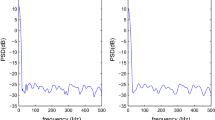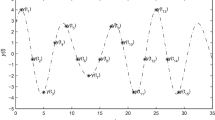Abstract
The sine signals are widely used in signal processing, communication technology, system performance analysis and system identification. Many periodic signals can be transformed into the sum of different harmonic sine signals by using the Fourier expansion. This paper studies the parameter estimation problem for the sine combination signals and periodic signals. In order to perform the online parameter estimation, the stochastic gradient algorithm is derived according to the gradient optimization principle. On this basis, the multi-innovation stochastic gradient parameter estimation method is presented by expanding the scalar innovation into the innovation vector for the aim of improving the estimation accuracy. Moreover, in order to enhance the stabilization of the parameter estimation method, the recursive least squares algorithm is derived by means of the trigonometric function expansion. Finally, some simulation examples are provided to show and compare the performance of the proposed approaches.







Similar content being viewed by others
References
N. Andrei, An adaptive conjugate gradient algorithm for large-scale unconstrained optimization. J. Comput. Appl. Math. 292, 83–91 (2016)
D. Belega, D. Petri, Sine-wave parameter estimation by interpolated DFT method based on new cosine windows with high interference rejection capability. Digit. Signal Process. 33, 60–70 (2014)
D. Belega, D. Petri, Accuracy analysis of the sine-wave parameters estimation by means of the windowed three-parameter sine-fit algorithm. Digit. Signal Process. 50, 12–23 (2016)
X. Cao, D.Q. Zhu, S.X. Yang, Multi-AUV target search based on bioinspired neurodynamics model in 3-D underwater environments. IEEE Trans. Neural Netw. Learn. Syst. (2016). doi:10.1109/TNNLS.2015.2482501
J. Chen, Y. Ren, G. Zeng, An improved multi-harmonic sine fitting algorithm based on Tabu search. Measurement 59, 258–267 (2015)
Z.Z. Chu, D.Q. Zhu, S.X. Yang, Observer-based adaptive neural network trajectory tracking control for remotely operated Vehicle. IEEE Trans. Neural Netw. Learn. Syst. (2016). doi:10.1109/TNNLS
S. Deng, Z. Wan, A three-term conjugate gradient algorithm for large-scale unconstrained optimization problems. Appl. Num. Math. 92, 70–81 (2015)
F. Ding, System Identification-Performances Analysis for Identification Methods (Science Press, Beijing, 2014)
F. Ding, X.M. Liu, Y. Gu, An auxiliary model based least squares algorithm for a dual-rate state space system with time-delay using the data filtering. J. Franklin Inst. 353(2), 398–408 (2016)
F. Ding, P.X. Liu, G.J. Liu, Gradient based and least-squares based iterative identification methods for OE and OEMA systems. Digit. Signal Process. 20(3), 664–677 (2010)
F. Ding, X.M. Liu, M.M. Liu, The recursive least squares identification algorithm for a class of Wiener nonlinear systems. J. Franklin Inst. 353(7), 1518–1526 (2016)
F. Ding, X.M. Liu, X.Y. Ma, Kalman state filtering based least squares iterative parameter estimation for observer canonical state space systems using decomposition. J. Comput. Appl. Math. 301, 135–143 (2016)
F. Ding, X.H. Wang, Q.J. Chen, Y.S. Xiao, Recursive least squares parameter estimation for a class of output nonlinear systems based on the model decomposition. Circuits Syst. Signal Process. 35(9), 3323–3338 (2016)
J. Guo, Y.L. Zhao, C.Y. Sun, Y. Yu, Recursive identification of FIR systems with binary-valued outputs and communication channels. Automatica 60, 165–172 (2015)
M. Jafari, M. Salimifard, M. Dehghani, Identification of multivariable nonlinear systems in the presence of colored noises using iterative hierarchical least squares algorithm. ISA Trans. 53(4), 1243–1252 (2014)
A. Janot, P. Vandanjon, M. Gautier, A revised Durbin–Wu–Hausman test for industrial robot identification. Control Eng. Pract. 48, 52–62 (2016)
Y. Ji, X.M. Liu, F. Ding, New criteria for the robust impulsive synchronization of uncertain chaotic delayed nonlinear systems. Nonlinear Dyn. 79(1), 1–9 (2015)
Y. Ji, X.M. Liu, Unified synchronization criteria for hybrid switching-impulsive dynamical networks. Circuits Syst. Signal Process. 34(5), 1499–1517 (2015)
X. Li, F. Ding, Signal modeling using the gradient search. Appl. Math. Lett. 26(8), 807–813 (2013)
H. Li, Y. Shi, W. Yan, On neighbor information utilization in distributed receding horizon control for consensus-seeking. IEEE Trans. Cybern. (2016). doi:10.1109/TCYB.2015.2459719
H. Li, Y. Shi, W. Yan, Distributed receding horizon control of constrained nonlinear vehicle formations with guaranteed \(\gamma \)-gain stability. Automatica 68, 148–154 (2016)
J. Li, Y.J. Zheng, Z.P. Lin, Recursive identification of time-varying systems: self-tuning and matrix RLS algorithms. Syst. Control Lett. 66, 104–110 (2014)
Y.W. Mao, F. Ding, A novel data filtering based multi-innovation stochastic gradient algorithm for Hammerstein nonlinear systems. Digit. Signal Process. 46, 215–225 (2015)
I. Necoara, V. Nedelcu, On linear convergence of a distributed dual gradient algorithm for linearly constrained separable convex problems. Automatica 55, 209–216 (2015)
J. Pan, X.H. Yang, H.F. Cai, B.X. Mu, Image noise smoothing using a modified Kalman filter. Neurocomputing 173, 1625–1629 (2016)
J. Vörös, Iterative algorithm for parameter identification of Hammerstein systems with two-segment nonlinearities. IEEE Trans. Autom. Control 44(11), 2145–2149 (1999)
D.Q. Wang, Hierarchical parameter estimation for a class of MIMO Hammerstein systems based on the reframed models. Appl. Math. Lett. 57, 13–19 (2016)
D.Q. Wang, F. Ding, Parameter estimation algorithms for multivariable Hammerstein CARMA systems. Inf. Sci. 355–356(10), 237–248 (2016)
Y.J. Wang, F. Ding, Novel data filtering based parameter identification for multiple-input multiple-output systems using the auxiliary model. Automatica 71, 308–313 (2016)
Y.J. Wang, F. Ding, The filtering based iterative identification for multivariable systems. IET Control Theory Appl. 10(8), 894–902 (2016)
Y.J. Wang, F. Ding, The auxiliary model based hierarchical gradient algorithms and convergence analysis using the filtering technique. Signal Process. 128, 212–221 (2016)
Y.J. Wang, F. Ding, Recursive least squares algorithm and gradient algorithm for Hammerstein–Wiener systems using the data filtering. Nonlinear Dyn. 84(2), 1045–1053 (2016)
T.Z. Wang, J. Qi, H. Xu et al., Fault diagnosis method based on FFT-RPCA-SVM for cascaded-multilevel inverter. ISA Trans. 60, 156–163 (2016)
T.Z. Wang, H. Wu, M.Q. Ni et al., An adaptive confidence limit for periodic non-steady conditions fault detection. Mech. Syst. Signal Process. 72–73, 328–345 (2016)
D.Q. Wang, W. Zhang, Improved least squares identification algorithm for multivariable Hammerstein systems. J. Franklin Inst. 352(11), 5292–5307 (2015)
L. Xu, A proportional differential control method for a time-delay system using the Taylor expansion approximation. Appl. Math. Comput. 236, 391–399 (2014)
L. Xu, The damping iterative parameter identification method for dynamical systems based on the sine signal measurement. Signal Process. 120, 660–667 (2016)
L. Xu, Application of the Newton iteration algorithm to the parameter estimation for dynamical systems. J. Comput. Appl. Math. 288, 33–43 (2015)
L. Xu, L. Chen, W.L. Xiong, Parameter estimation and controller design for dynamic systems from the step responses based on the Newton iteration. Nonlinear Dyn. 79(3), 2155–2163 (2015)
X.P. Xu, F. Wang, G.J. Liu, Identification of Hammerstein systems using key-term separation principle, auxiliary model and improved particle swarm optimisation algorithm. IET Signal Process. 7(8), 766–773 (2013)
Y. Zhang, Unbiased identification of a class of multi-input single-optput systems with correlated disturbances using bias compensation methods. Math. Comput. Model. 53(9–10), 1810–1819 (2011)
G.Q. Zhang, X.K. Zhang, H.S. Pang, Multi-innovation auto-constructed least squares identification for 4 DOF ship manoeuvring modelling with full-scale trial data. ISA Trans. 58, 186–195 (2015)
S.X. Zhao, F. Wang, H. Xu, J. Zhu, Multi-frequency identification method in signal processing. Digit. Signal Process. 19(4), 555–566 (2009)
Acknowledgments
This work was supported by the National Natural Science Foundation of China (No. 61273194) and Natural Science Fund for Colleges and Universities in Jiangsu Province (No. 12KJB120005).
Author information
Authors and Affiliations
Corresponding author
Rights and permissions
About this article
Cite this article
Xu, L., Ding, F. Recursive Least Squares and Multi-innovation Stochastic Gradient Parameter Estimation Methods for Signal Modeling. Circuits Syst Signal Process 36, 1735–1753 (2017). https://doi.org/10.1007/s00034-016-0378-4
Received:
Revised:
Accepted:
Published:
Issue Date:
DOI: https://doi.org/10.1007/s00034-016-0378-4




